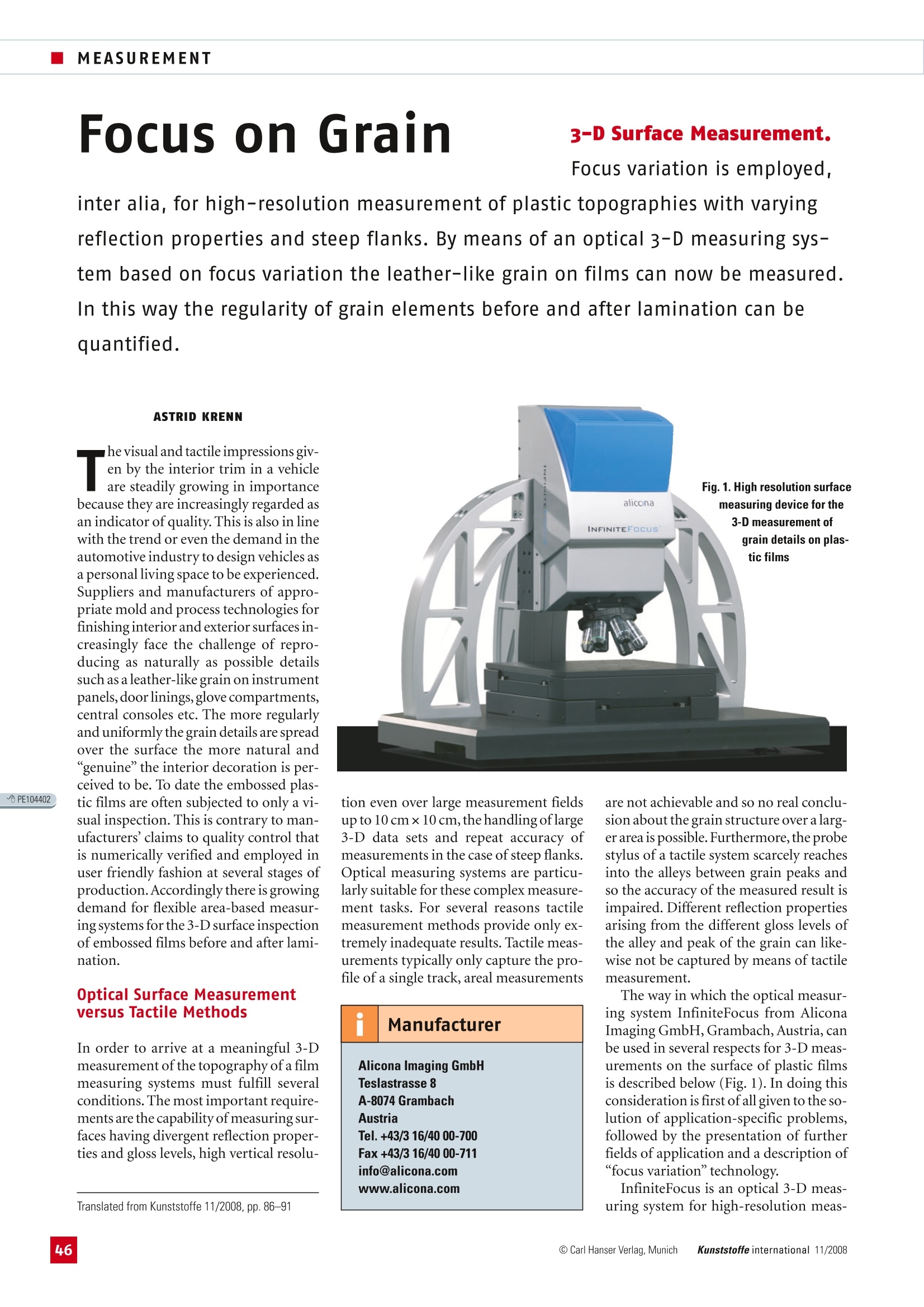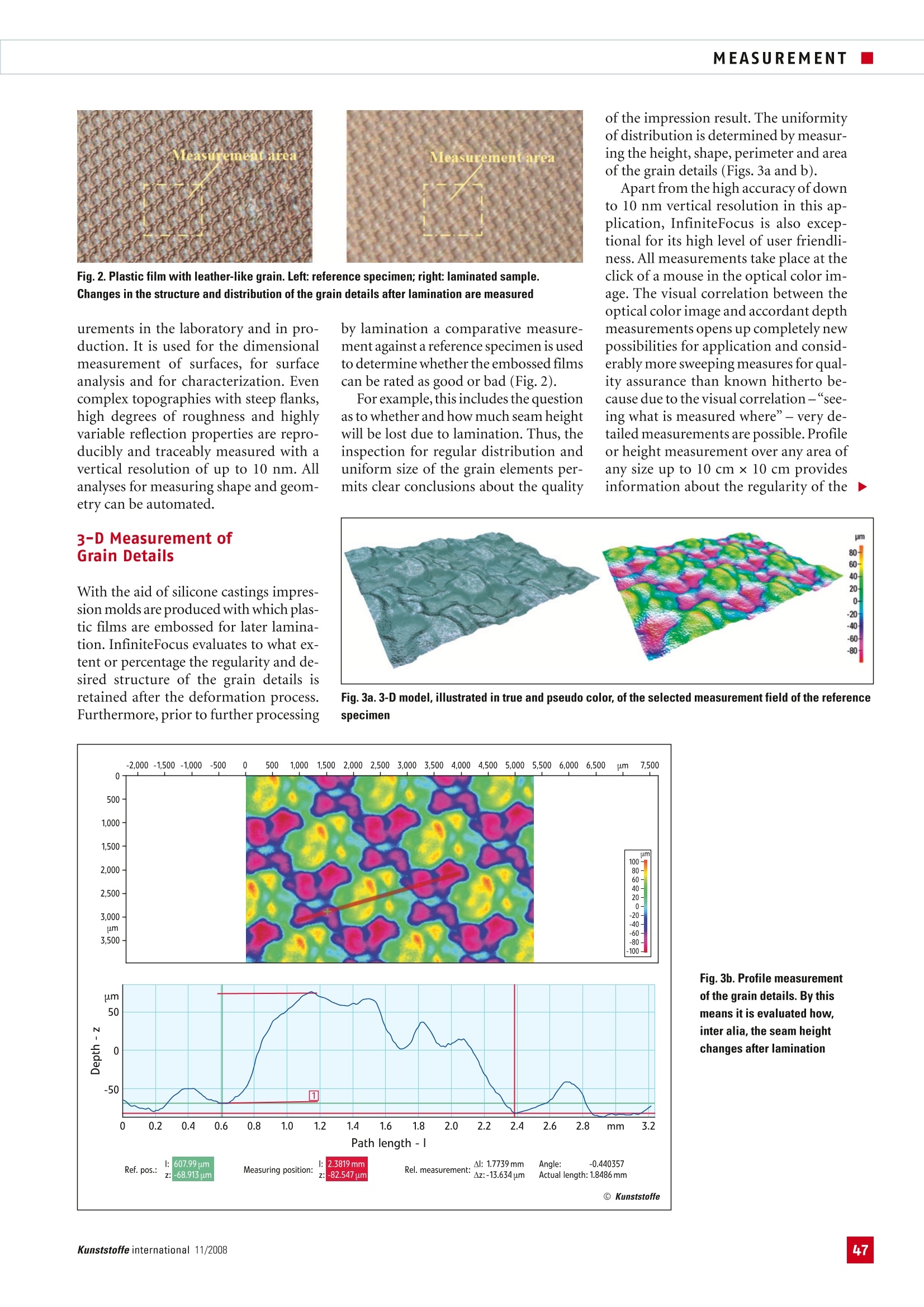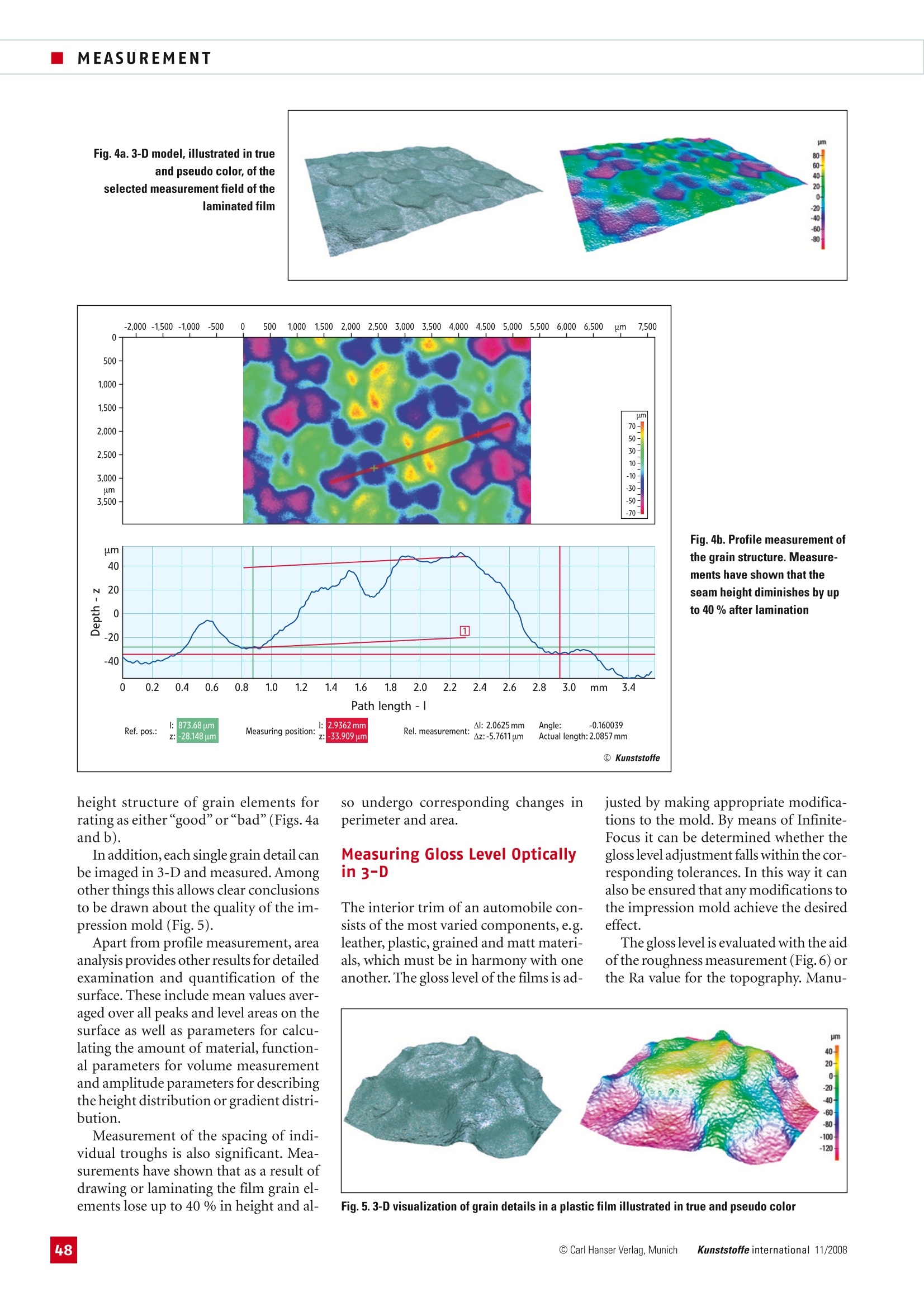
方案详情
文
Focus variation is employed,inter alia,for high-resolution measurement of plastic topographies with varying reflection properties and steep flanks.By meas of an optical 3D measuring system based on focus variation the leather-like grain on films can now be measured.In this way the regularity of grain elements before and sfter lamination can be quantified.
方案详情

M EASUREMENT Focus on Grain 3-D Surface Measurement. Focus variation is employed, inter alia, for high-resolution measurement of plastic topographies with varyingreflection properties and steep flanks. By means of an optical 3-D measuring sys-tem based on focus variation the leather-like grain on films can now be measured.In this way the regularity of grain elements before and after lamination can bequantified. he visual and tactile impressions giv-Ten by the interior trim in a vehicleare steadily growing in importancebecause they are increasingly regarded asan indicator of quality. This is also in linewith the trend or even the demand in theautomotive industry to design vehicles asa personal living space to be experienced.Suppliers and manufacturers of appro-priate mold and process technologies forfinishing interior and exterior surfaces in-creasingly face the challenge of repro-ducing as naturally as possible detailssuch as aleather-like grain on instrumentpanels, door linings, glove compartments,central consoles etc. The more regularlyand uniformly the grain details are spreadover the surface the more natural and“genuine"the interior decoration is per-ceived to be. To date the embossed plas-tic films are often subjected to only a vi-sual inspection. This is contrary to man-ufacturers’claims to quality control thatis numerically verified and employed inuser friendly fashion at several stages ofproduction. Accordingly there is growingdemand for flexible area-based measur-ing systems for the 3-D surface inspectionof embossed films before and after lami-nation. Optical Surface Measurementversus Tactile Methods In order to arrive at a meaningful 3-Dmeasurement of the topography of a filmmeasuring systems must fulfill severalconditions. The most important require-ments are the capability of measuring sur-faces having divergent reflection proper-ties and gloss levels, high vertical resolu- tion even over large measurement fieldsup to 10 cm×10 cm, the handling oflarge3-D data sets and repeat accuracy ofmeasurements in the case of steep flanks.Optical measuring systems are particu-larly suitable for these complex measure-ment tasks. For several reasons tactilemeasurement methods provide only ex-tremely inadequate results. Tactile meas-urements typically only capture the pro-file of a single track, areal measurements i Manufacturer Alicona Imaging GmbH Teslastrasse 8 A-8074 Grambach Austria Tel.+43/3 16/40 00-700 Fax+43/3 16/40 00-711 info@alicona.com www.alicona.com are not achievable and so no real conclu-sion about the grain structure over a larg-er area is possible. Furthermore,the probestylus of a tactile system scarcely reachesinto the alleys between grain peaks andso the accuracy of the measured result isimpaired. Different reflection propertiesarising from the different gloss levels ofthe alley and peak of the grain can like-wise not be captured by means of tactilemeasurement. The way in which the optical measur-ing system InfiniteFocus from AliconaImaging GmbH,Grambach, Austria, canbe used in several respects for 3-Dmeas-urements on the surface of plastic filmsis described below (Fig. 1). In doing thisconsideration is first of all given to the so-lution of application-specific problems,followed by the presentation of furtherfields of application and a description of“focus variation"technology. InfiniteFocus is an optical 3-D meas-uring system for high-resolution meas- Fig. 2. Plastic film with leather-like grain. Left: reference specimen; right: laminated sample.Changes in the structure and distribution of the grain details after lamination are measured of the impression result. The uniformityof distribution is determined by measur-ing the height, shape, perimeter and areaof the grain details (Figs. 3a and b). Apart from the high accuracy of downto 10 nm vertical resolution in this ap-plication, InfiniteFocus is also excep-tional for its high level of user friendli-ness. All measurements take place at theclick of a mouse in the optical color im-age. The visual correlation between theoptical color image and accordant depthmeasurements opens up completely newpossibilities for application and consid-erably more sweeping measures for qual-ity assurance than known hitherto be-cause due to the visual correlation-“see-ing what is measured where"- very de-tailed measurements are possible.Profileor height measurement over any area ofany size up to 10 cm × 10 cm providesinformation about the regularity of the urements in the laboratory and in pro-duction. It is used for the dimensionalmeasurement of surfaces, for surfaceanalysis and for characterization. Evencomplex topographies with steep flanks,high degrees of roughness and highlyvariable reflection properties are repro-ducibly and traceably measured with avertical resolution of up to 10 nm. Allanalyses for measuring shape and geom-etry can be automated. 3-D Measurement ofGrain Details With the aid of silicone castings impres-sion molds are produced with which plas-tic films are embossed for later lamina-tion. InfiniteFocus evaluates to what ex-tent or percentage the regularity and de-sired structure of the grain details isretained after the deformation process.Furthermore, prior to further processing by lamination a comparative measure-ment against a reference specimen is usedto determine whether the embossed filmscan be rated as good or bad (Fig.2). For example, this includes the questionas to whether and how much seam heightwill be lost due to lamination. Thus, theinspection for regular distribution anduniform size of the grain elements per-mits clear conclusions about the quality Fig.3a.3-D model, illustrated in true and pseudo color, of the selected measurement field of the referencespecimen Fig.3b. Profile measurementof the grain details. By thismeans it is evaluated how,inter alia, the seam heightchanges after lamination Fig.4a.3-Dmodel, illustrated in trueand pseudo color, of theselected measurement field of thelaminated film Fig. 4b. Profile measurement ofthe grain structure. Measure-ments have shown that theseam height diminishes by upto 40 % after lamination height structure of grain elements forrating as either “good”or“bad”(Figs. 4aand b). In addition, each single grain detail canbe imaged in 3-D and measured. Amongother things this allows clear conclusionsto be drawn about the quality of the im-pression mold (Fig.5). Apart from profile measurement, areaanalysis provides other results for detailedexamination and quantification of thesurface.These include mean values aver-aged over all peaks and level areas on thesurface as well as parameters for calcu-lating the amount of material, function-al parameters for volume measurementand amplitude parameters for describingthe height distribution or gradient distri-bution. Measurement of the spacing of indi-vidual troughs is also significant. Mea-surements have shown that as a result ofdrawing or laminating the film grain el-ements lose up to 40 % in height and al- so undergo corresponding changes inperimeter and area. Measuring Gloss Level Opticallyin 3-D The interior trim of an automobile con-sists of the most varied components,e.g.leather,plastic, grained and matt materi-als, which must be in harmony with oneanother. The gloss level of the films is ad- justed by making appropriate modifica-tions to the mold. By means of Infinite-Focus it can be determined whether thegloss level adjustment falls within the cor-responding tolerances. In this way it canalso be ensured that any modifications tothe impression mold achieve the desiredeffect. The gloss level is evaluated with the aidof the roughness measurement (Fig.6) orthe Ra value for the topography. Manu- facturers usually employ the estab-lished method of inferring the con-stitution of the sample from the in-tensity of the reflected light. Thismeasurement,however, has little evi-dential value since the results are notnumerically verifiable. Focus Variation Technology The InfiniteFocus measuring device isbased on focus variation (Fig.7). Theprincipal of this is in turn based onthe small depth of focus of an opticalsystem with vertical scanning to pro-vide topographical and color infor-mation from the variation of focus. The key component of InfiniteFo-cus is a precision optics containingdifferent lens systems and can be fit-tedwith various objectives so that ob-jects can be measured in maximumresolution. With the aid of a beamsplitter light from a white light sourceis directed into the optical pathway ofthe device and focused on the sampleby the objective lens. When the lightstrikes the sample it is reflected in dif-ferent directions depending on theconstitution of the sample.In the caseof diffuse surfaces reflection ensuesuniformly in all directions while in thecase of specular topographies this occursmainly in one direction only. All emanat-ing light beams incident on the objectiveare focused by the optics and at the rearside of the mirror strike a photosensitivesensor. Due to the depth of field of thesystem only relatively small areas of theobject are sharply captured. In order toallow a 3-D measurement and the pro- Fig. 6. Roughness measurement determines the gloss level ofthe laminated film ceeds in several steps. First of allfor each point measured by thesensor a sharpness index is calcu-lated in order to determine the Zposition at which each point in theobject was most sharply imaged.A 3-D measured value is provid-ed for each object point. The literature discloses variousmethods for calculating tthesharpness of definition of an im-age based on evaluation of thegray scale data. It is generally thecase that an object point is imagedall the more sharply the greater thedegree of variation in the sensorvalues in a small local area. Ac-cordingly, one of the most com-mon measures of sharpness is tolist all values in a small local areaand to use their standard devia-tion as a measure of the sharpness. On account of the large vol-umes of data involved it is possi-ble to bypass mechanical limita-tions. In this way high-resolutionmeasured values for each Z posi-tion are obtained. As soon as theheight data have been topograph-ically captured a color image hav-ing continuous focal depth is pro-duced. Focus variation in its current form hasbeen adopted for the new ISO standard25178 for the standardization of opticalmeasuring techniques. In addition to tac-tile methods, this new standard also en-compasses for the first time optical meth-ods together with the definition of sur-face parameters for the areal characteri-zation of surfaces. Alicona is an officially delegated expertto the corresponding standard commit-tee and is actively collaborating in furtherstandardization activities. ■ THE AUTHORESS MAG. ASTRID KRENN, born in 1977, is responsi-ble for marketing at Alicona Imaging GmbH;astrid.krenn@alicona.com For online research of past and present articles please visit our archive at www.kunststoffe-international.com Translated from Kunststoffe pp. Carl Hanser Verlag, Munich Kunststoffe international unststoffe international
确定




还剩2页未读,是否继续阅读?
北京东方德菲仪器有限公司为您提供《聚焦颗粒中三维表面检测方案(轮廓仪)》,该方案主要用于其他中三维表面检测,参考标准--,《聚焦颗粒中三维表面检测方案(轮廓仪)》用到的仪器有
相关方案
更多
该厂商其他方案
更多








